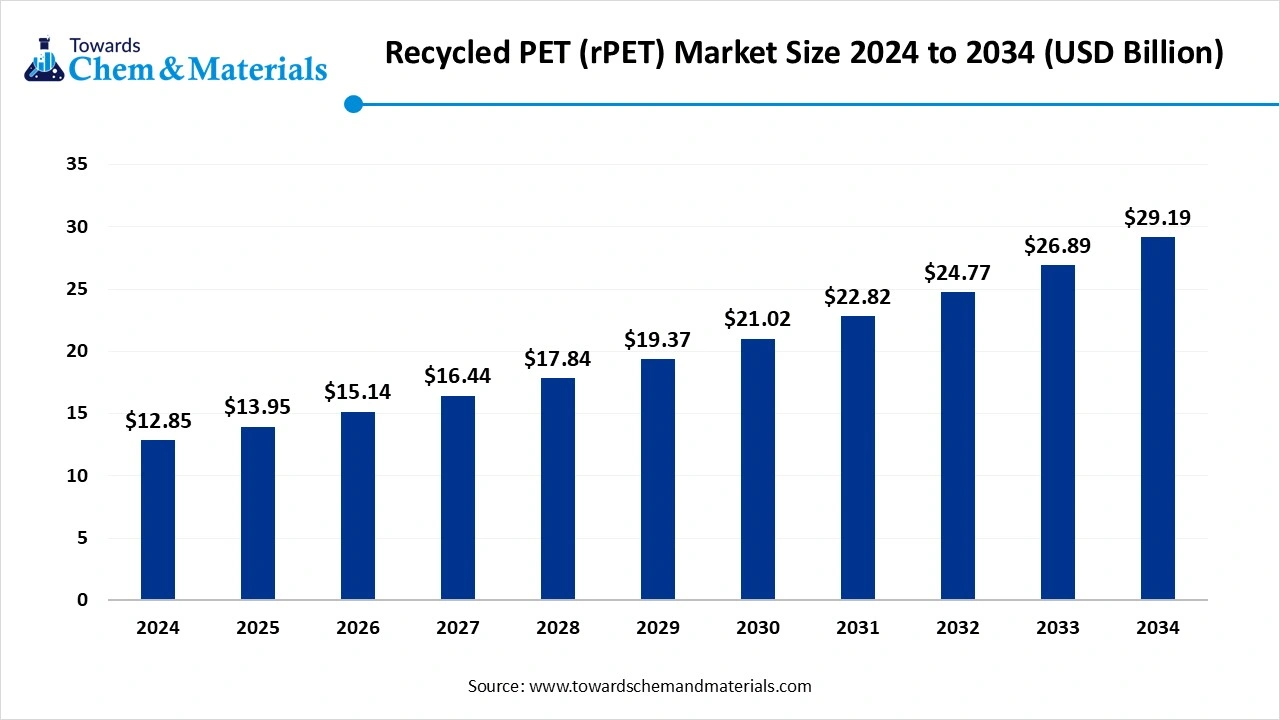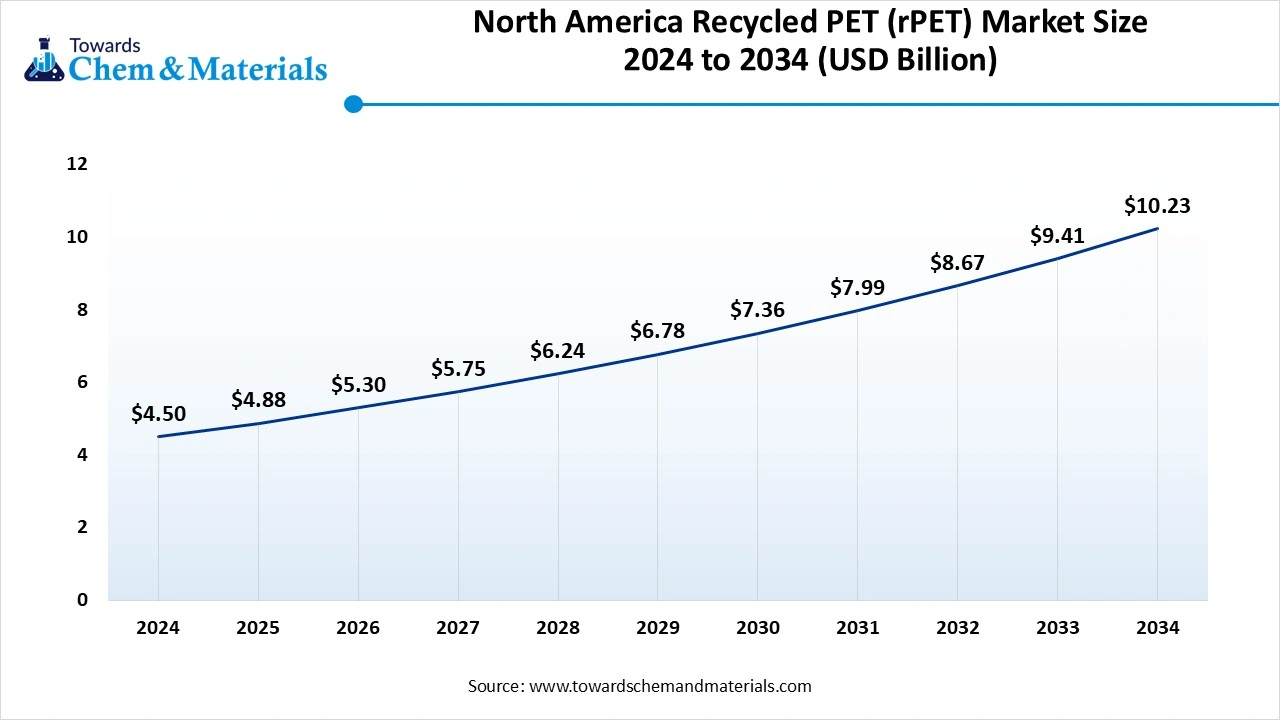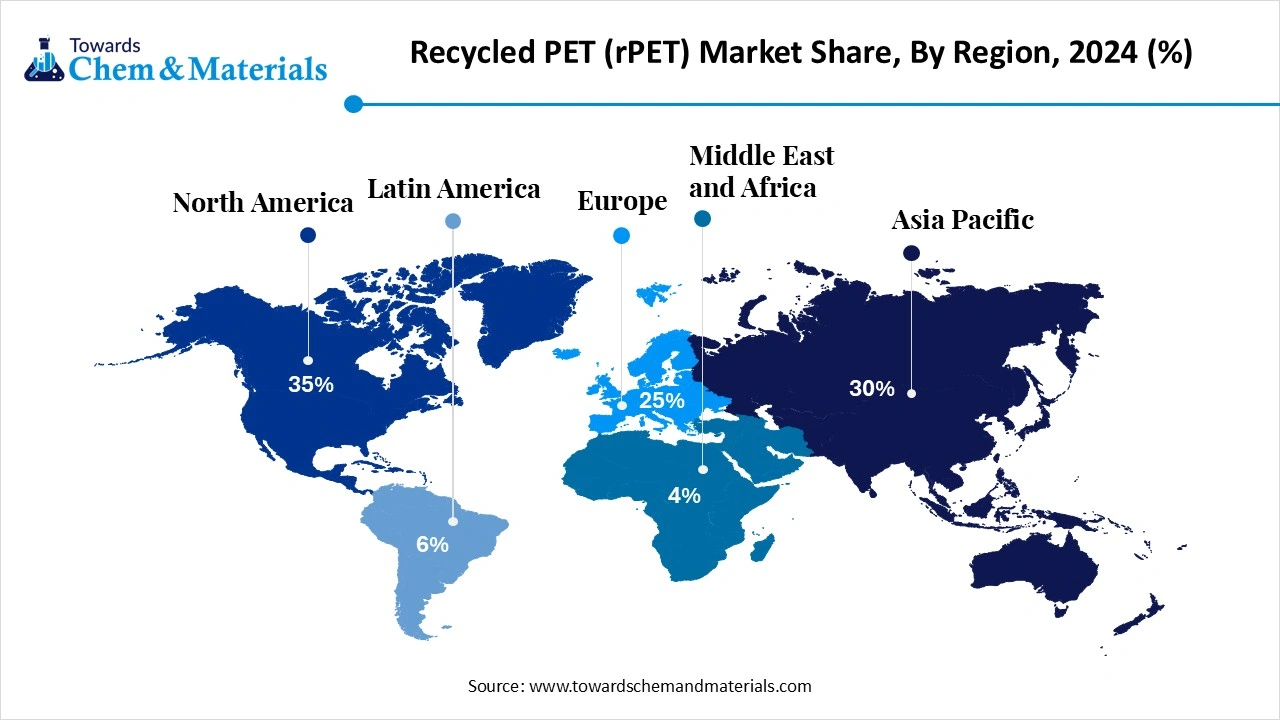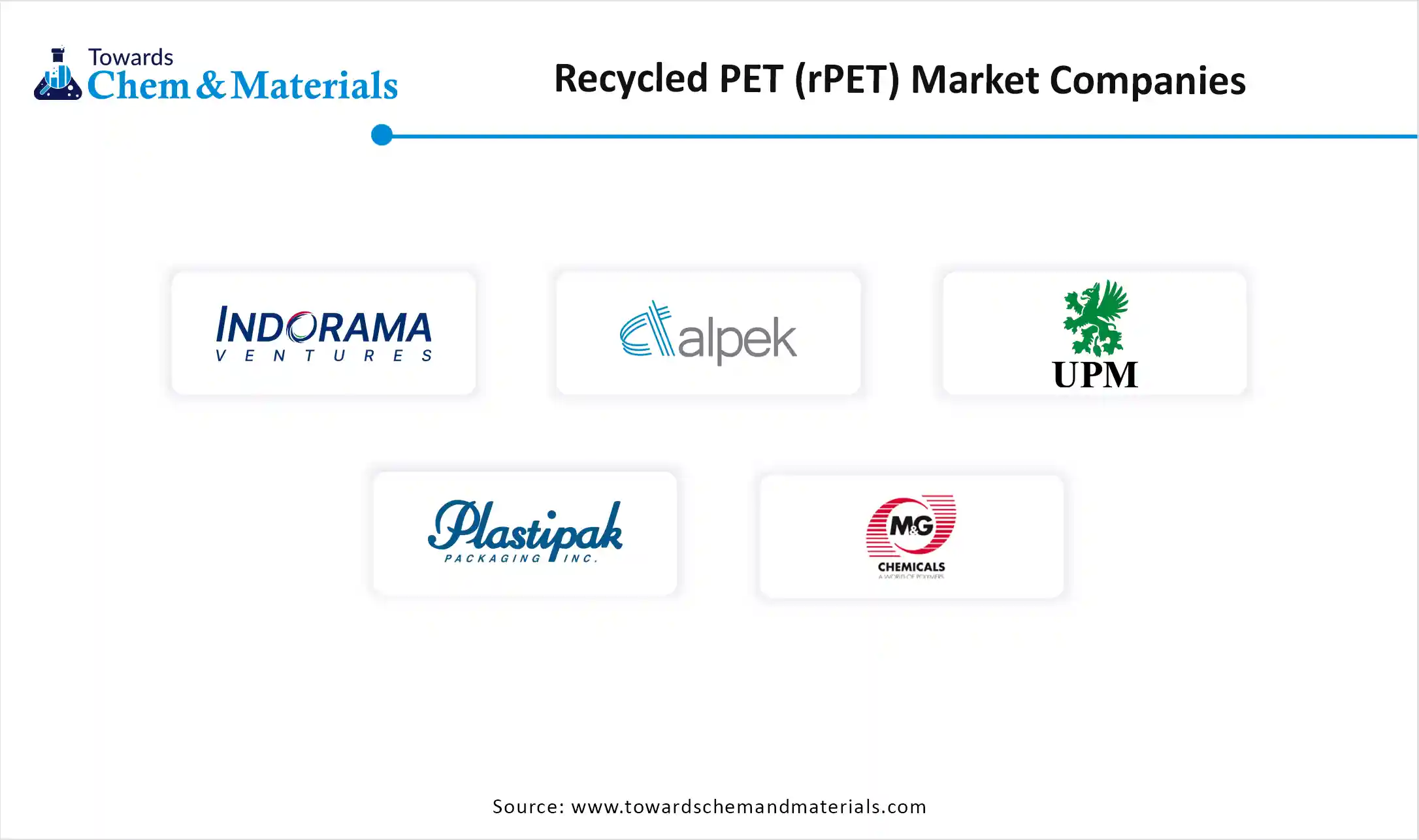November 2025
The global recycled PET (rPET) market size was reached at USD 12.85 billion in 2024 and is expected to be worth around USD 29.19 billion by 2034, growing at a compound annual growth rate (CAGR) of 8.55% over the forecast period 2025 to 2034. The growth of the market is driven by the increasing consumer awareness of the environment, and the use of sustainable packaging increases the demand and growth of the market.

The recycled PET (rPET) market refers to the industry involved in the production and consumption of recycled polyethylene terephthalate (PET) materials. PET, a widely used plastic, is collected from post-consumer products (such as bottles and packaging) or post-industrial waste, then processed and reformed into new products. rPET is used primarily in the manufacturing of containers, bottles, fibers for textiles, automotive components, and various other consumer goods. The market aims to reduce environmental impact by reusing plastic, reducing the need for virgin PET production, and supporting a circular economy.
The growth of the market is driven by the growing consumer awareness and demand for sustainable packaging due to growing environmental concerns, which fuel the growth of the market. The shift towards circular economy and use of reused and recycled materials is increasing focus furling growth. The growing food and beverages industry demand for PET packaging, due to the growing focus on sustainability, fuels the growth. Other key drivers are the supportive government policies and regulations, growth in end-use applications, and emerging market drives the growth and expansion of the market.
| Report Attributes | Details |
| Market Size in 2025 | USD 13.95 Billion |
| Expected Size by 2034 | USD 29.19 Billion |
| Growth Rate from 2025 to 2034 | CAGR 8.55% |
| Base Year of Estimation | 2024 |
| Forecast Period | 2025 - 2034 |
| Dominant Region | North America |
| Segment Covered | By Source, By End-Use Industry, By Form, By Application, By Recycling Process, By Region |
| Key Companies Profiled | Indorama Ventures, Alpek , UPM-Kymmene Corporation , Plastipak Packaging , M&G Chemicals , Evergreen Plastics , Loop Industries , Origin Materials , Coca-Cola Company , Veolia , CarbonLite Industries , PET Recycling Team , Clear Path Recycling , Green Line Polymers , Suez Group , Stamina Group , KW Plastics , Magnum Group, UltrePET , Nextek Limited |
What Are The Key Growth Opportunities That Support The Growth Of The Recycled PET (rPET) Market?
The key growth opportunity for the recycled pet (rPET) market is the growing demand of consumers for sustainable and eco-friendly packaging due to rising environmental concerns among conscious consumers, which supports the growth of the market. The sustainable packaging adoption to meet the sustainability goals and align with the consumers' preferences is a great opportunity for the growth of the market.
The rise of circular economy models is further promoting the use of recycled materials and fostering collaborations between stakeholders to secure stable supply chains. These factors support the growth by creating opportunities for expansion of the market further.
The key challenge that hinders the growth of the market is contamination and imperfections in the PET waste, which significantly reduce the quality of the rPET, high processing costs due to new and advanced technologies, inconsistent regulations, availability and quality of feedstock, small bottle recycling, and label adhesives, which limit the growth and expansion of the market.
The North America recycled PET (rPET) market size was estimated at USD 4.50 billion in 2024 and is projected to reach USD 10.23 billion by 2034, growing at a CAGR of 8.56% from 2025 to 2034.

North America dominated the recycled PET (rPET) market in 2024. The growth of the market is driven by growing sustainability concerns due to increasing awareness of plastic pollution and landfill overflow, driving the growth and demand for the market in the region.
The government regulations with supportive policies like bottle deposit legislation and mandates for recycled content in packaging are encouraging the use of rPET also contributes to the growth of the market. The key players like Verdeco Recycling Inc., Phoenix Technologies International LLC, Envision Plastics Industries LLC, Unifi Manufacturing Inc., and DAK Americas LLC also play a significant role in the growth and expansion of the market in the region.
Asia Pacific is Experiencing Growth, Driven By Rapid Industrialization
Asia Pacific is expected to witness significant growth in the recycled PET (rPET) market in the forecast period. The growth of the market is driven by rapid industrialization, urbanization, and supportive government initiatives, which fuel the growth. The growing use and application in various industries due to the growing use of recycled materials and shift towards sustainability fuels the growth of the market in the region. The key players also play a significant role in teg growth of the market through innovation and advanced technology for improving the efficiency and quality of rPET production fuels the growth and expansion of the market in the region.

India Has Seen Significant Growth, Driven By The Growing Packaging Industry.
India has seen significant growth, driven by the growing textile industry with increased demand in the market. Companies like Hindustan Unilever are increasing the use of rPET in packaging, further boosting demand for the market in the country. The growing consumer awareness about the impact of environmental impact of plastic waste increases the adoption of more sustainable packaging solutions, which fuels the growth of the market in the country.
Which Source Segment Dominated the Recycled PET (rPET) Market in 2024?
The post-consumer PET segment dominated the market in 2024. Post-consumer PET is the primary source of recycled PET, collected from used bottles, packaging, and containers. It plays a vital role in sustainable packaging solutions as the beverage and consumer goods industries aim to reduce plastic waste. The growing adoption of closed-loop recycling and eco-friendly initiatives by global brands is boosting demand for post-consumer PET, making it the largest contributor to rPET production.
The post-consumer PET segment expects significant growth in the market during the forecast period. Post-industrial PET is obtained from factory waste, including scraps and rejected PET products. It offers consistent quality and purity, making it highly suitable for fiber production and technical applications. Manufacturers increasingly prefer post-industrial PET due to its reliability, cost efficiency, and minimal contamination levels. As industries focus on waste reduction and resource efficiency, the utilization of post-industrial PET continues to grow across the packaging and textile sectors.
How did the Packaging Segment Dominate the Recycled PET (rPET) Market in 2024?
The packaging segment dominated the market in 2024. Packaging is the leading end-use segment for recycled PET, widely applied in bottles, containers, and thermoformed products. The food and beverage industry is a major driver, with companies incorporating rPET into packaging to align with sustainability targets. The demand for lightweight, durable, and environmentally friendly packaging materials is accelerating rPET adoption. This segment plays a central role in global efforts to replace virgin plastics with recycled alternatives.
The textile segment expects significant growth in the market during the forecast period. The textile industry represents a significant market for rPET, particularly in clothing, sportswear, and home furnishings. rPET fibers are valued for their strength, versatility, and eco-friendly profile, making them a preferred choice for sustainable fashion. Major apparel brands are actively incorporating rPET into their product lines to meet consumer expectations for ethical and green materials. This has established textiles as one of the fastest-growing segments for rPET applications.
Which Form Segment Dominated the Recycled PET (rPET) Market in 2024?
The r-pet resin segment dominated the market in 2024. rPET resin serves as a versatile raw material, used extensively in bottles, containers, and sheet extrusion. It has become increasingly important in the beverage industry, where brand owners integrate recycled resin into packaging to meet environmental goals. Resin is also used in industrial products where clarity and strength are required. Its adaptability across applications makes it a crucial force driving the expansion of the market.
The r-pet fiber segment expects significant growth in the market during the forecast period. rPET fiber is a major form used in textiles, carpets, automotive interiors, and nonwoven fabrics. Known for durability, recyclability, and cost-effectiveness, it supports industries seeking greener alternatives. The apparel sector, in particular, is expanding the use of rPET fibers to create sustainable clothing lines. With increasing consumer preference for environmentally conscious products, rPET fibers have become an important material choice in both fashion and industrial markets.
How did the Bottle Segment Dominate the Recycled PET (rPET) Market in 2024?
The bottles segment dominated the market in 2024. Bottles are the largest application segment for rPET, particularly in food and beverage packaging. Global companies are committing to higher recycled content in plastic bottles, driving sustained demand for rPET. This application supports circular economy practices by reintroducing used PET bottles into production cycles. The segment is strongly influenced by regulatory pressures, sustainability goals, and consumer awareness, making rPET bottles central to plastic waste reduction strategies.
The fibers segment expects significant growth in the market during the forecast period. Fibers represent a substantial application area for recycled PET, used in textiles, upholstery, and industrial fabrics. rPET fibers offer a sustainable alternative to virgin polyester, reducing environmental impact while delivering strong performance characteristics. Fashion, home décor, and technical textiles industries are major contributors to this demand. The growing awareness of eco-friendly products and the rising popularity of sustainable fabrics have made fibers a key driver of the market.
Which Recycling Process Segment Dominated the Recycled PET (rPET) Market in 2024?
The mechanical recycling segment dominated the market in 2024. Mechanical recycling is the most common process used for converting PET waste into rPET products. It is cost-effective, widely adopted, and capable of producing high-quality materials for packaging and textiles. This method involves cleaning, shredding, and reprocessing PET waste into usable pellets or flakes. Although dependent on clean input material, its efficiency and established infrastructure make it the dominant recycling method in the recycled PET industry.
The chemical recycling segment expects significant growth in the market during the forecast period. Chemical recycling is gaining momentum as a cutting-edge process for producing high-quality rPET. Breaking PET down into its base monomers allows for nearly infinite recyclability and the production of food-grade rPET. This technology is particularly valuable in applications requiring purity and high performance, such as beverage bottles and advanced packaging. Growing investment in chemical recycling facilities highlights its potential to complement mechanical recycling in the market.
Chemical Synthesis and Processing : The recycled PET (rPET) is synthesised and processed through methanolysis, glycolysis, and hydrolysis.
Quality Testing and Certification : The recycled PET (rPET) requires the Global Recycled Standard certification and the Recycled Claim Standard (RCS).
Distribution to Industrial Users : The recycled PET (rPET) is distributed to the packaging, automotive, textile, and construction industries.

By Source
By End-Use Industry
By Form
By Application
By Recycling Process
By Region
The global sustainable construction material market size is calculated at USD 483.73 billion in 2025 and is forecasted to reach around USD 1,400.77 bi...
Market analysis indicates that, the global chitosan market size was estimated at USD 16.19 billion in 2024 and is predicted to increase from USD 19.48...
November 2025
October 2025
October 2025
October 2025